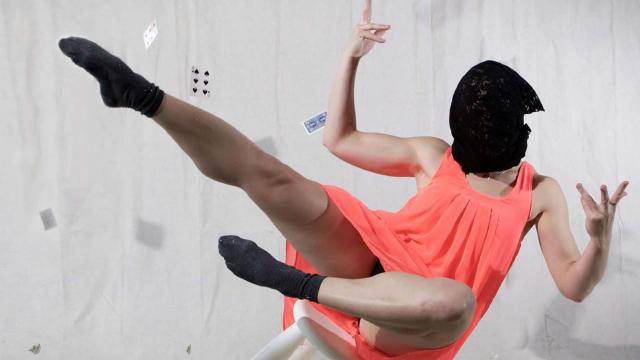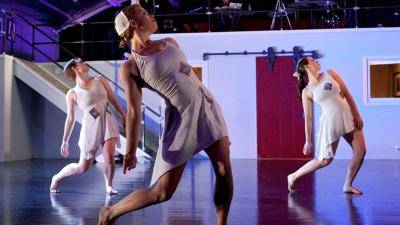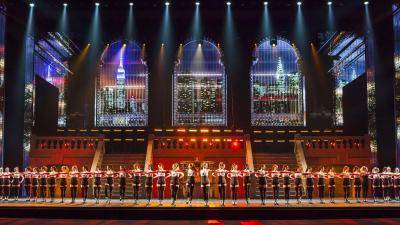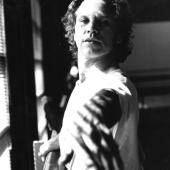Los Angeles Contemporary Dance Company returned to the Brewery and the spacious, workman-like Diavolo Dance Theater stage for two weekends of performances of four new works. With two works from within the company and two from without, LACDC Artistic Director Kate Hutter continues to enlarge the scope of the company's repertory. The four shorter pieces present a change of direction from recent performances of the evening length God's and Marionettes presented at the Ford Theatre and Bovard Auditorium and show the company in a nimbler context of stand-alone dance and music.
The Nature of Things posed a new way of presenting concert work by pitching the pieces on the diagonal with seating surrounding two sides of the rectangular stage. It is a subtle change but for the pieces on the program, which all relate slightly skewed contexts, the reorganized stage proved a clever adaptation. On the first half of the program were Identity Theft with choreography by Hutter and Nana with choreography by LACDC company member Genevieve Carson. On the second half No Words by Seth Zibalese and Plastique choreographed by Catch Me Bird's Nehara Kalev were two polarized versions of concert dance, one from a choreographer with connections to the world of commercial dance and the other from the world of performance art. Identity Theft and Nana proved the strongest pairing indicating that perhaps companies behave like organisms with cohesion and personality that comes from shared history.
Identity Theft for five dancers is striking for the fact that all dancer's heads are wrapped so that their faces are invisible. And were in not for the fact that the sound score is a collage of ethnic Arabic sources the political and social commentary might be less of a double edged. The costuming in dark and grey layers is not identical but the absence of faces in the fifteen minute piece leads you away from labeling by sex and personality. In the end, eerily haunting as well as soothing dimensions begin to rise out of anonymity in motion. The unison sections which predominate are particularly effective, one with two women, another with a man and a woman and at times all five. For the smaller sections the dances pull to the back of the stage where they wait in darkness. The lighting is mostly darkened with no color. The movement from time to time is punctuated with verbal commands, fall, get up, stop, a guide for the visually impaired but also a glimpse into a world where people respond to powerful outside forces. The sound score pulled together disparate elements from Zoe Keating, the Iranian Maestro's Ensemble and Turkish field recordings into an effective, unified score.
Genevieve Carson's work Nana based on the life of her nonagenarian grandmother was visually appealing and made the most of theatrical effects and rich lighting by Mason Barker. Drea Sobke as the central character proved an irresistible force on stage who both acted and danced with dramatic flair. She also turned in a lengthy and memorable solo filled with broad physical comedy as she tries to haul a large table across the stage. Much of the action centers on decks of cards which finally litter the stage, a re-imagined reference to someone dedicated to solitaire as a way of passing time.
The piece opens with the sounds of cards being fanned and a bored-to-death Sobke lying on the stage and flailing with her hands and body in a scattered deck. The movement flashes into motion with a snow storm of decks flung skyward by the dancers. That and the final image, with Sobke seated at her table in a down pool of light as torn cards fall from on high, owe a debt to European dance theatre but the effect here feels integral, not copied. The costuming put Sobke in a white dress with the remaining women in print sun dresses. The two men, Zsolt Banki and Michael Crotty, are attired in khakis and dress shirts. The mood was that of a vague, nostalgic past. The costuming was by Hutter. The majority of the score for Nana uses the music of Penguin Café Orchestra which deconstructs in the end through an original composition by Austin Wintory. As the sunny music of Simon Jeffes gives way to a soundscape of fractured, distorted sound we understand that the issues of memory falter with age. The remaining dancers were Hyosun Choi, Tiffany Sweat and Angel Tyson.
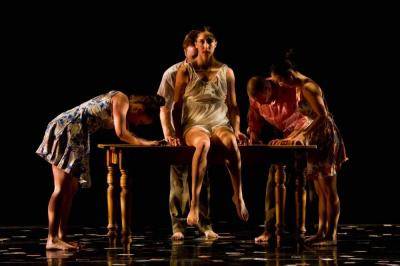
Zibalese's duo, No Words, danced by Genevieve Carson and Michael Crotty, fell into a familiar scenario of the troubled and aggressive relationship. It looked sometimes too much like duets driven by pop and contemporary music. We sense the aggressive instinct and comfort zones being breached but it was less clear what exactly they might be after in the long run. But it was Carson's powerful, technique-laden dancing that was the driving force here. The music, by indie band Bon Iver, swung easily between a kind of gospel riff and folk-rock. Concluding the program was Plastique, which takes place on the mid- Pacific gyre of plastic and garbage, a kind of later-day floating gardens of Xochimilco, where the artificial rules. It is more of a visual examination than actual guidebook but the appealing look of Kalev's work makes you feel that perhaps, as horrid as it sounds, such a life might be possible and look cool at the same time. It poses the ultimate evolutionary question: adapt and move on, or call it a day!
As Plastique opens, the dancers are set up on a pile of Styrofoam packaging peanuts. Wadded together, they endure an uncomfortable proximity that gradually develops into something that looks more or less like a communal existence. The dancing evolves through a series of solos and ensembles as the dancers come forward from a semicircle of miniature white plastic stools. They are arranged obliquely to the audience. The costuming and set pieces are all sparkling white, making you wonder if Kalev's island dwellers haven't found a way of processing a Road Warrior existence of actual filth into something that looks scrubbed clean by technology, salt and sun. Throughout the piece, plastic continues to fall to the stage, letting us know that we are burying ourselves in the stuff and that it won't be stopping any time soon. The glowing lighting and costuming were by Mason Barker and Hutter respectively.
(The performance took place on Saturday May 14, 2011 at the Diavolo Dance Theater)
